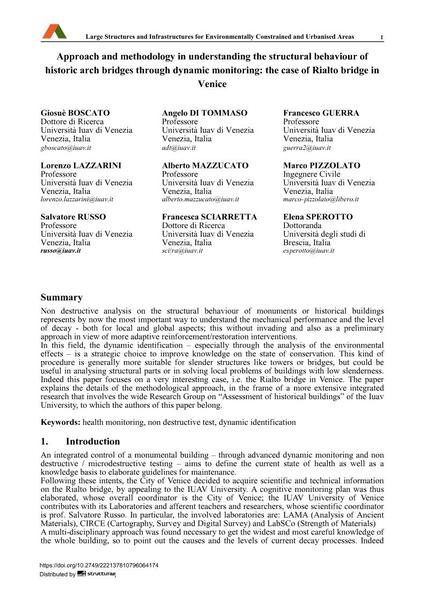Approach and methodology in understanding the structural behaviour of historic arch bridges through dynamic monitoring: the case of Rialto bridge in Venice

|
|
|||||||||||
Détails bibliographiques
| Auteur(s): |
Giosuè Boscato
Angelo Di Tommaso Francesco Guerra Lorenzo Lazzarini Alberto Mazzucato Marco Pizzolato Salvatore Russo Francesca Sciarretta Elena Sperotto |
||||
|---|---|---|---|---|---|
| Médium: | papier de conférence | ||||
| Langue(s): | anglais | ||||
| Conférence: | IABSE Symposium: Large Structures and Infrastructures for Environmentally Constrained and Urbanised Areas, Venice, Italy, 22-24 September 2010 | ||||
| Publié dans: | IABSE Symposium Venice 2010 | ||||
|
|||||
| Page(s): | 890-891 | ||||
| Nombre total de pages (du PDF): | 8 | ||||
| Année: | 2010 | ||||
| DOI: | 10.2749/222137810796064174 | ||||
| Abstrait: |
Non destructive analysis on the structural behaviour of monuments or historical buildings represents by now the most important way to understand the mechanical performance and the level of decay - both for local and global aspects; this without invading and also as a preliminary approach in view of more adaptive reinforcement/restoration interventions. In this field, the dynamic identification – especially through the analysis of the environmental effects – is a strategic choice to improve knowledge on the state of conservation. This kind of procedure is generally more suitable for slender structures like towers or bridges, but could be useful in analysing structural parts or in solving local problems of buildings with low slenderness. Indeed this paper focuses on a very interesting case, i.e. the Rialto bridge in Venice. The paper explains the details of the methodological approach, in the frame of a more extensive integrated research that involves the wide Research Group on “Assessment of historical buildings” of the Iuav University, to which the authors of this paper belong. |
||||
